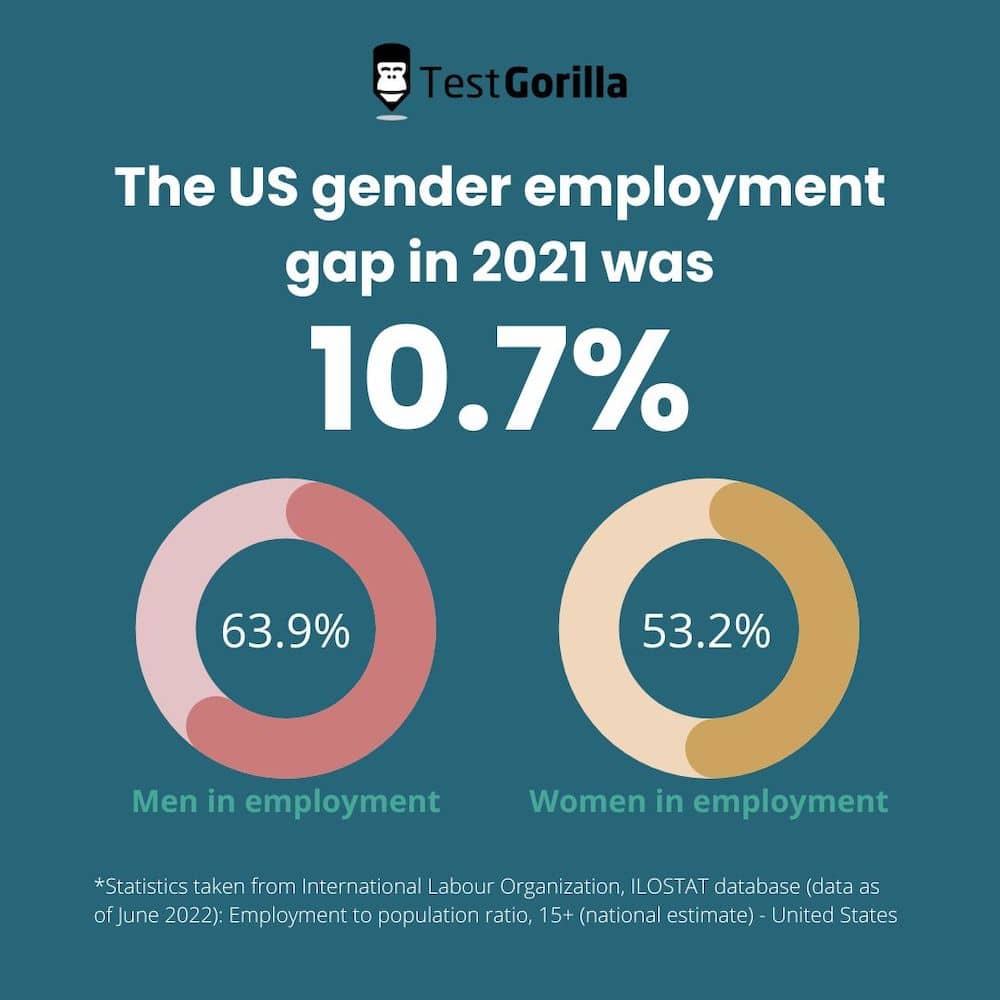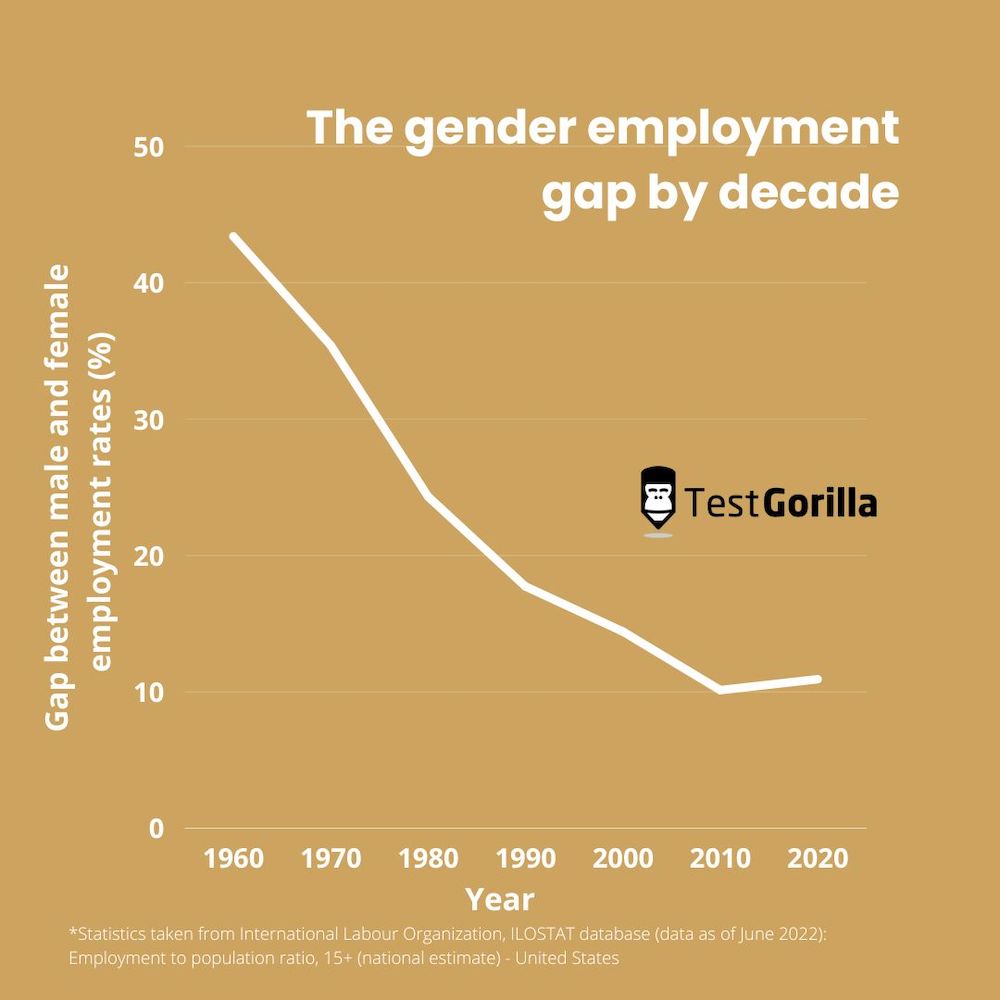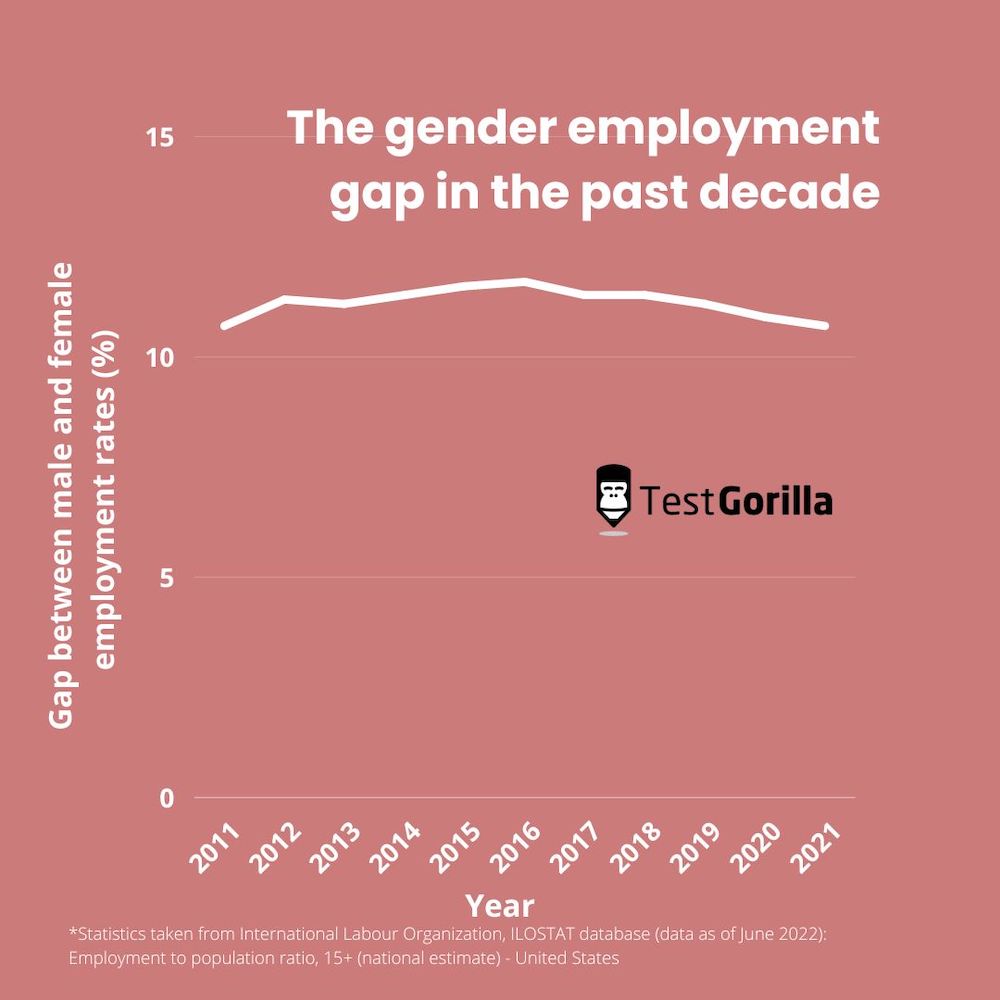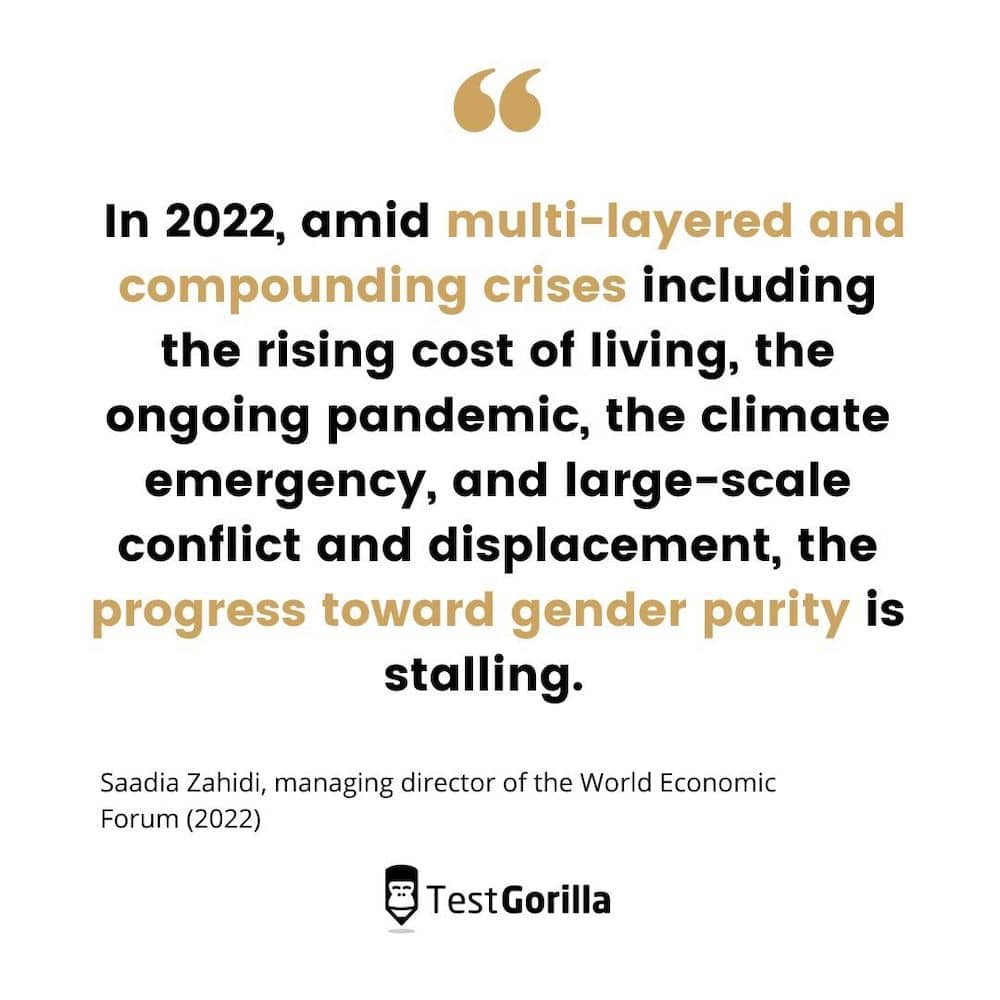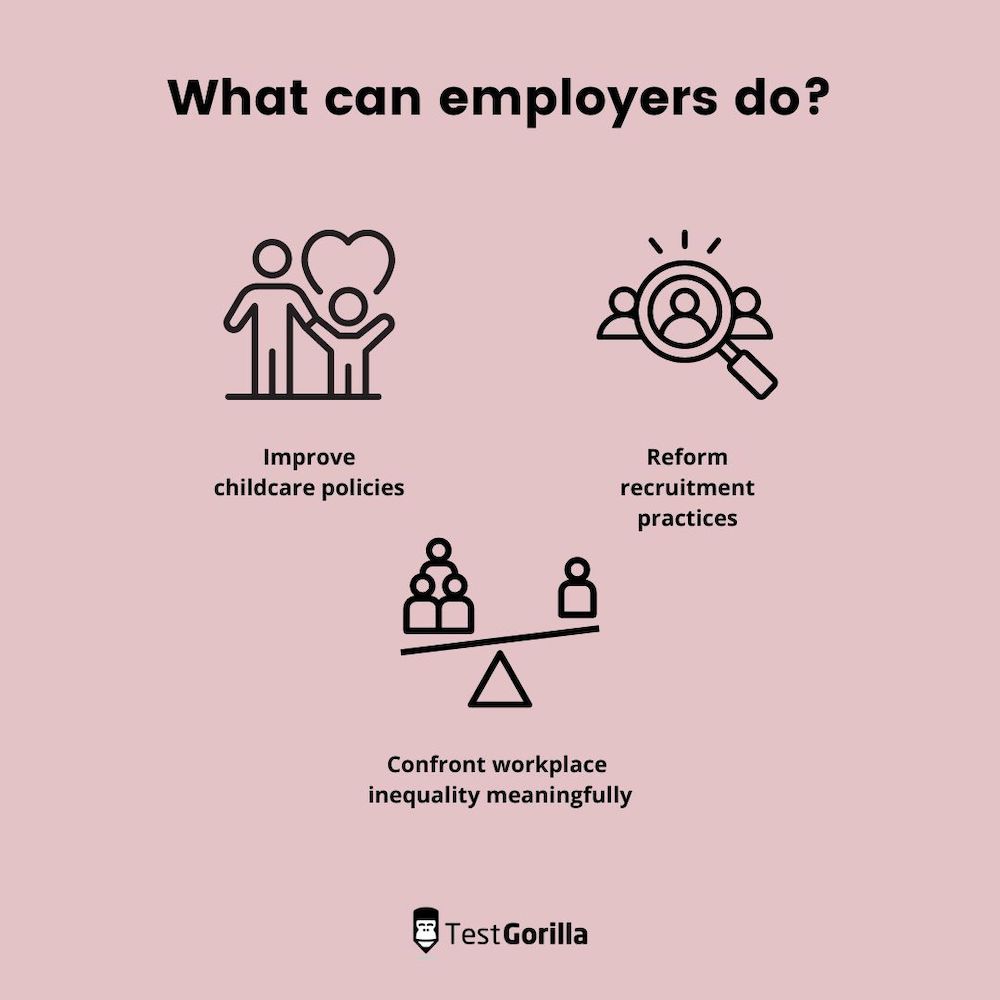You only need to go on Twitter on International Women’s Day to glean the extent to which companies claim to support, appreciate, and celebrate women. And yet the gender pay gap, a pivot for discourse about precisely how companies don’t support women, persists: They are still earning 17% less than men on average in the US, and estimates suggest it will take more than 250 years to close this gap at the current rate of progress.
The barriers to gender equality are still many and depressing. They lurk behind even the best of intentions since we all harbor unconscious bias in varying degrees. At TestGorilla, we’re invested in changing recruitment processes for the better: Employers need to move away from broken hiring practices, and we’re here to help them do it. So we want to invite you to peer into another kind of gap.
In this blog, we’ll take a deep dive into the gender employment gap – the difference between the percentages of men versus women who are in employment. Unfortunately, gender inequality is still reported on in a binary way, with little guidance on how to include non-binary and transgender employees in gap calculations. This makes it harder to unpack the implications of the gap in an inclusive way, but the message is still clear: Traditional recruitment practices are a stubborn obstacle to gender equality and workplace diversity.
Let’s talk about the gender employment gap
The gender pay gap rightly gets a lot of attention; it’s a chief indicator of the inequalities that persist once women are inside the workspaces they’ve historically been denied access to. The gender employment gap tends to get less press. Both demonstrate inequality of opportunity, but there’s a key difference in what their figures can tell us.
While the gender pay gap lays bare the wage disparity experienced by women and the difference in the quality of opportunities available to these genders, the gender employment gap shows us that there’s an imbalance in representation in the workforce as a whole. The former is a question of how different men’s and women’s experiences are once they’re working; the latter is about how accessible the workplace is to them in the first place.
While the gender pay gap lays bare the wage disparity experienced by women and the difference in the quality of opportunities available to these genders, the gender employment gap shows us that there’s an imbalance in representation in the workforce as a whole. The former is a question of how different men’s and women’s experiences are once they’re working; the latter is about how accessible the workplace is to them in the first place.
To be clear, the closing of either gap does not necessarily equate to equality of opportunity. It can’t – inequality is complex, and there’s a myriad of other things to consider that make working life complicated for women. Nonetheless, these gaps represent one way of quantifying progress and identifying areas where crucial work needs to be done. Employment, the evidence shows us, is one such area.
According to data provided by the International Labour Organization, the US gender employment gap was 10.7% in 2021. This number represents more than half a century of improvement in equality of opportunity: In 1960, when mainstream cultural ideas about the role of women in US society began to change, the employment gap stood at 43.4%. This means that it’s more than four times smaller than it was 61 years ago, a dramatic change that most of us have seen unfold during our lifetimes.
It’s an encouraging change, but progress is slowing down – if we zoom in on the past decade, the data shows that progress in closing the US gender employment gap has pretty much come to a standstill. Although it might look as though we’re closer to equality than ever in the grand scheme of things, advances towards equal employment have reached a plateau.
The employment gap between men and women in 2021 is the same as it was in 2011, with small increases happening in the interim. What’s more, US government data from 2020 shows a 9% difference between transgender and cisgender people over 18 who are not in the workforce, bringing a significant but underresearched gap to light.
A diverse workplace is a just (and enriched) workplace
The pursuit of gender equality doesn’t need justification. But beyond it simply being the right thing to do, businesses can put themselves at an advantage by being more accessible and accommodating to women, transgender, and non-binary people. Unsurprisingly, an attractive stack of benefits accompanies gender diversity.
In cultures that are generally gender-inclusive, gender diversity increases productivity for companies. Recent research by Harvard Business Review concludes that increased gender diversity is directly followed by better performance: In one example, a 10% increase in Blau’s gender diversity index resulted in roughly a 7% increase in market value. Other research suggests that a transition from a single-gender office to one evenly split between men and women would result in a 41% revenue increase.
The reason behind these benefits has soundbite status in the business world: Diverse teams perform better. By having more women in the workforce at every level, businesses reap the benefits of diversity of thought, where different viewpoints and ideas lead to better problem-solving, and teams are better equipped to serve a diverse customer base.
By having more women, and in particular, more disabled women, more women of color, and more LGBT+ people represented at a board level, workplaces will become richer in ideas, experiences, and perspectives.
Jemima Olchawski, chief executive of the Fawcett Society (2022)
Gender diversity also has welfare benefits. In its Women in the Workplace 2021 report, McKinsey found that female managers take more consistent actions to promote employee wellbeing than men at the same level, so their employees are happier and less burned out. Female leaders are also twice as likely to prioritize diversity, equity, and inclusion.
Why are things stalling?
We have the evidence – the bottom line is, gender diversity is good for business and welfare. And we have the sentiment – nowadays, most Americans support gender equality. So why are things stalling?
In the historic fight for gender equality, many of the barriers to female employment have been chipped down. Although blatant sexism is still kicking around, what we’re now often faced with are the dregs of inequality; sexist microaggressions and unconscious biases so commonplace that they’ve sunk to the bottom of our psyches.
We have to work hard to uncover them: Left to build up, they are substantial enough to keep the gaps we want to close wedged open.
When it comes to employment in the US, there are three key frontiers making up the fight to close the employment gap between men and women: Childcare expectations, workplace inequality, and recruitment bias. Let’s take a closer look at each.
Childcare expectations
Women are still expected to prioritize their family over their work to a greater extent than men. Analysis shows that, although women now have the higher wage in 38% of heterosexual couples, 13% of women in these couples still leave work after they have a child, compared with only 3% of their lower-wage partners. And working mothers aren’t unaffected either: Sociologists use the term motherhood penalty to describe the biological and cultural disadvantages in pay and perceived competence that they experience at work.
This is one persisting disparity that keeps the gender employment gap roughly where it is now, with little changing over the past decade. For many women, childcare responsibilities are the preferred choice, but there’s no denying the influence of gender stereotypes behind these statistics. With these stereotypes intact, many women don’t feel as though they have a choice when it comes to domestic commitments.
Tellingly, improved childcare policies have the most consistent positive effect on women’s labor force engagement. Evidence from Latin American and Caribbean countries, where almost half of all women of working age are out of employment, shows that reductions in childcare costs and improved availability boost female labor market participation significantly.
As the refrain goes, women can’t do it all. And if they try to, they are likely to be penalized anyway. Until we achieve a fairer redistribution of domestic labor, adjustments must be made to make employment more accessible to people with children. Improved maternity leave, flexible work arrangements, and accessible and affordable childcare will be crucial to closing the gender employment gap.
Workplace inequality
Heterosexual women are so likely to earn less money than their partners that it often seems logical for them to stop working after the arrival of a child; in this way, gender pay gaps and gender employment gaps overlap and facilitate one another. The Covid-19 pandemic has had a disproportionate impact on working women precisely because they are overrepresented in low-wage jobs; professions dominated by women and people of color, such as care, are undervalued and excluded from employment protections.
Problems facing women in the labor market have never been hidden, but they have been inconvenient to address because they are so entrenched in the basic operations of our economy and society. The low wages associated with “pink collar” occupations have long contributed to the feminization of poverty, and the chronic shortage of affordable, high-quality childcare reflects outdated notions of women’s societal roles.
These gaps intersect with others – women are far more likely to experience harassment in the workplace and less likely to be promoted or occupy executive-level positions, while women of color are especially likely to face disrespectful behavior – and this produces a sticky web of inequity in the workplace. More women than men have quit their jobs in what’s being called the Great Resignation, citing reasons such as non-supportive managers, lack of promotion opportunities, and not being heard.
Women are less likely to be rewarded for, or hired for, the skills they actually have; it’s harder to advocate for yourself on a resume when your previous job titles don’t reflect your level of experience or competency.
Recruitment bias
To this point, traditional hiring processes are also complicit in maintaining the gender employment gap.
Gender bias is often present as soon as employers advertise open roles: In a study of 77,000 job ads, 478,175 words were thought to carry a gender bias that might endear these jobs to men more than women. But the crux of the problem lies in the dominant format for job applications, where candidates are evaluated on the basis of their CV.
CVs, which focus on education and work experience, are a minefield for amplifying unconscious bias. A study of more than 200,000 CVs from candidates applying to work for leading global businesses shines a light on how men and women use different language in their CVs. It shows that men are more likely to use words like “engineer,” “analyst,” “investment,” and “leadership,” while equally qualified women were more likely to use more feminized words that employers consider weaker because of unconscious bias, such as “volunteer,” “assistant,” “organize,” and “social”. Women also tend to write longer CVs, with a more varied vocabulary of words. All factors affected hiring decisions, blowing qualified candidates out of the water for no good reason.
Why not remove the human factor, the unconscious bias, from CV-based hiring processes? Well, it turns out that algorithmic CV sorting models are biased, too. It is now widely understood that existing biases are seeping into supposedly impartial recruitment models that use artificial intelligence instead of people to evaluate CVs.
The best insights on HR and recruitment, delivered to your inbox.
Biweekly updates. No spam. Unsubscribe any time.
What can employers do?
These are three big problems, and they require big solutions. Some will be led by government policy, such as the UK government’s 2017 decision to make pay gap reporting mandatory for all businesses larger than 250 people. But employers are also capable of generating meaningful change.
Improve childcare policies
Things have changed a lot since 1960. But the benefits packages that employees receive today are still based on models that accommodate one working parent – specifically, a male one. The childcare crisis caused by the Covid-19 pandemic has demonstrated the ramifications of this, with working mothers bearing the fallout.
Childcare support should be part of your business infrastructure
In one survey, 26% of women who became unemployed during the pandemic said this was due to a lack of childcare, with women experiencing a higher increase in domestic responsibilities than men. Women were more likely to report reduced hours due to a lack of childcare if they were black or unmarried.
The childcare crisis is a clarion call for employers to treat childcare with the same seriousness as the benefits that good employers are already expected to provide, such as healthcare and pension schemes.
Employers need to expand policies and practices to support all working parents of children under the age of 18. Each stage of parenting delivers different challenges, parental needs, and most importantly, parental presence.
Alicia Sasser Modestino et al., Childcare is a Business Issue, Harvard Business Review (2021)
The rise of remote work is already paving the way. According to a recent KinderCare study, 69% of working parents say they’re more able to be present in their children’s lives because of more flexible work schedules.
The same study found that 34% of parents have switched jobs to be more available for their child, and 40% haven’t but would consider doing so. Companies that provide top childcare policies and benefits give employees the support they need to contribute fully at work, without the stress or anxiety of an unstable childcare situation. In today’s climate, this is one way for businesses to stay competitive among jobseekers and boost employee retention.
Employer-provided childcare services, subsidies, or benefits can change the game for working adults who have children. Since women take on a disproportionate amount of responsibility when childcare isn’t accessible to families, this approach could be vital in closing the employment gap.
Confront workplace inequality meaningfully
As awareness of workplace inequality increases, implementing methods to address it has become mainstream. Unconscious bias and diversity training are used to teach employees about how and why inequalities exist, the roles their own implicit and explicit biases play, and what they can do to curtail these and foster inclusion.
The problem is that most of this training misses the mark. An afternoon of awareness-raising is a weak opponent for a lifetime of exposure to, and ingestion of, prejudice and stereotypes. Employers must invest time, energy, money, and resources into putting together thoughtful, meaningful strategies for reducing workplace inequality and bias among employees.
Going above and beyond unconscious bias training
Mounting research demonstrates that unconscious bias training (UBT) doesn’t work. Amid a flurry of comments on the topic, the UK government announced that they would scrap UBT for civil-service workers in 2021 – a fair decision, perhaps, but one made without a replacement strategy in sight.
The verdict is that UBT can only reliably shift knowledge: It has little to no effect on people’s behaviors and attitudes. But, as London School of Economics’ Inclusion Initiative researcher Frederick Herbert argues, knowledge shifts are still valuable – in fact, they’re often a prerequisite for behavioral change. Although UBT fails as a standalone intervention, it can have value as a foundation to build upon.
Unfortunately, there’s an absence of valid and reliable research into other kinds of interventions, with few investigations into what is effective for different working environments. The best thing employers can do is strive to understand what works best for tackling discrimination in their own workplace. Approaches should be committed, robust, thoughtful, and continuous: UBT programs have been used as one-stop shops for too long.
Reform recruitment practices
Recruitment is in crisis. Even making CV-based recruitment “blind” or introducing algorithms is not enough to reduce hiring bias. No matter the context, bias is triggered by the way people and artificial intelligence engage with the CV as a concept.
With so much evidence showing that the CV enables bias and is an obstacle to closing the gender employment gap, the way recruitment happens needs to change. Employers need to bin the CV.
Skills-based hiring: An alternative to CVs
Skills-based hiring is an emerging recruitment strategy that puts relevant observable, measurable skills before qualifications and experience to identify the best candidates for a job. It requires companies to use assessments to evaluate their candidates’ skills before they look at a CV – ideally, they abandon the document altogether.
Although unconscious bias can’t be eliminated completely, being aware of it and taking steps to limit its influence on your decision-making goes a long way. When it comes to hiring, using data as the basis for your decisions is the most effective thing you can do to combat bias. By moving away from intuition and towards evidence, employers can force bias out of the picture.
Skills-testing platforms like TestGorilla can help employers acquire the data that tells them which candidates have the skills they need. Recruiters and hiring managers can set quantifiable, skills-based criteria for recruitment, rather than spending hours sifting through CVs and allowing unconscious bias to creep in.
Skills-based hiring has the power to shake up recruitment archetypes and change the way employment happens for the better. Its implementation can help companies reduce the influence of the most ingrained unconscious biases, gender bias included.
Skills-based hiring is a data-backed way to reduce gender bias
The premise is appealing, but does the data back it up?
Bluntly, yes it does. In a study of more than 2,000 skills-based hires into senior roles, conducted by the recruitment agency Applied, CVs were replaced by a series of skills and cognitive ability tests. The number of women hired for high-level positions increased by 68% from the global average, where CV-based hiring is the norm, and 52% of all successful candidates were women, up from a global average of 31%.
Closing employment gaps is about more than businesses doing better, and its welfare benefits exceed the workplace. The freedom to choose an occupation and the right to engage in work are listed in the European Union’s Charter of Fundamental Rights; in contemporary societies, paid employment is an entry ticket to comfort and freedom of consumption. In the US, it is a gatekeeper for access to healthcare. Equality of opportunity enables equal access to all of these things.
If you’re an employer and you want to tackle the gender employment gap, skills-based hiring needs to be on your radar. Progress is stalling because surface-level support does nothing to tackle stereotypes and unconscious bias. It’s time to do something that goes deeper to make a meaningful difference in increasing gender diversity: Ditch the CV and recruit for skills first. It’s not a silver bullet for equality, but it will certainly help level the playing field for your candidates, with knock-on benefits for you too.
Related posts
You've scrolled this far
Why not try TestGorilla for free, and see what happens when you put skills first.


